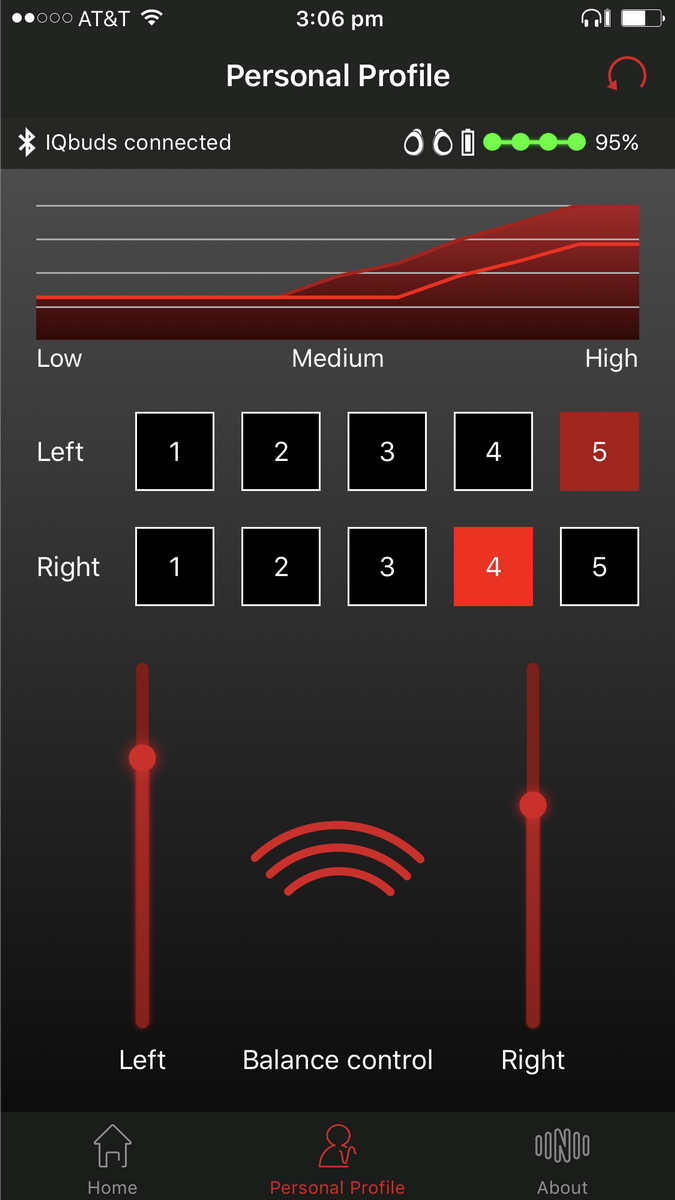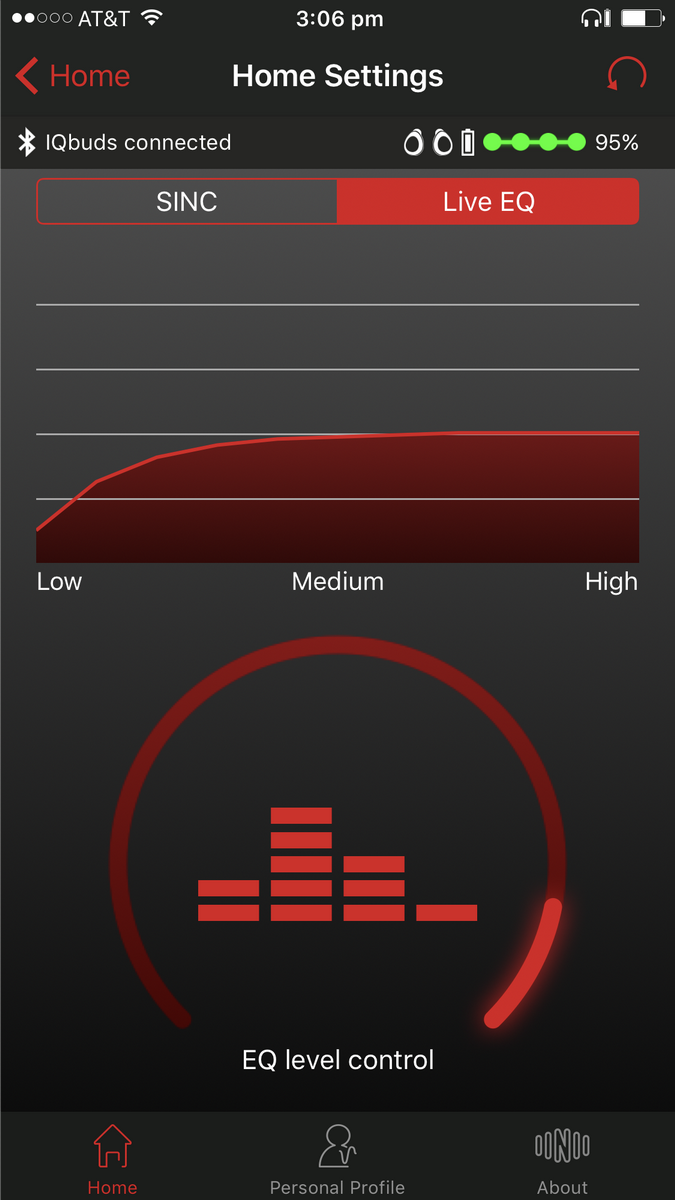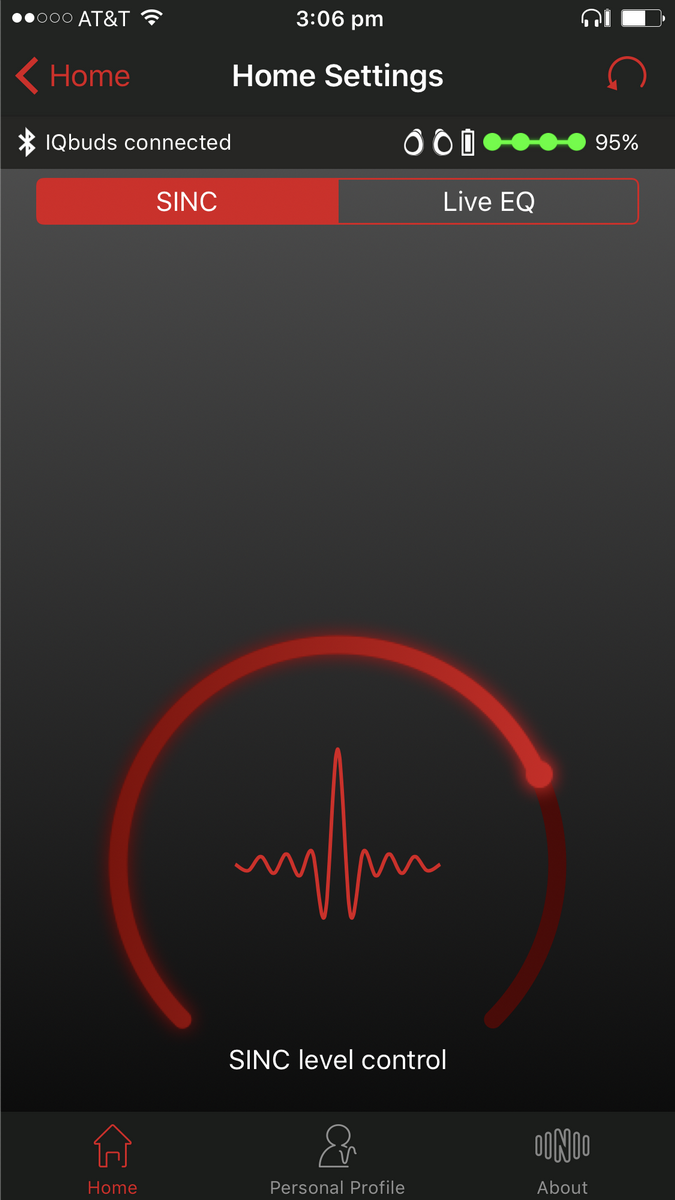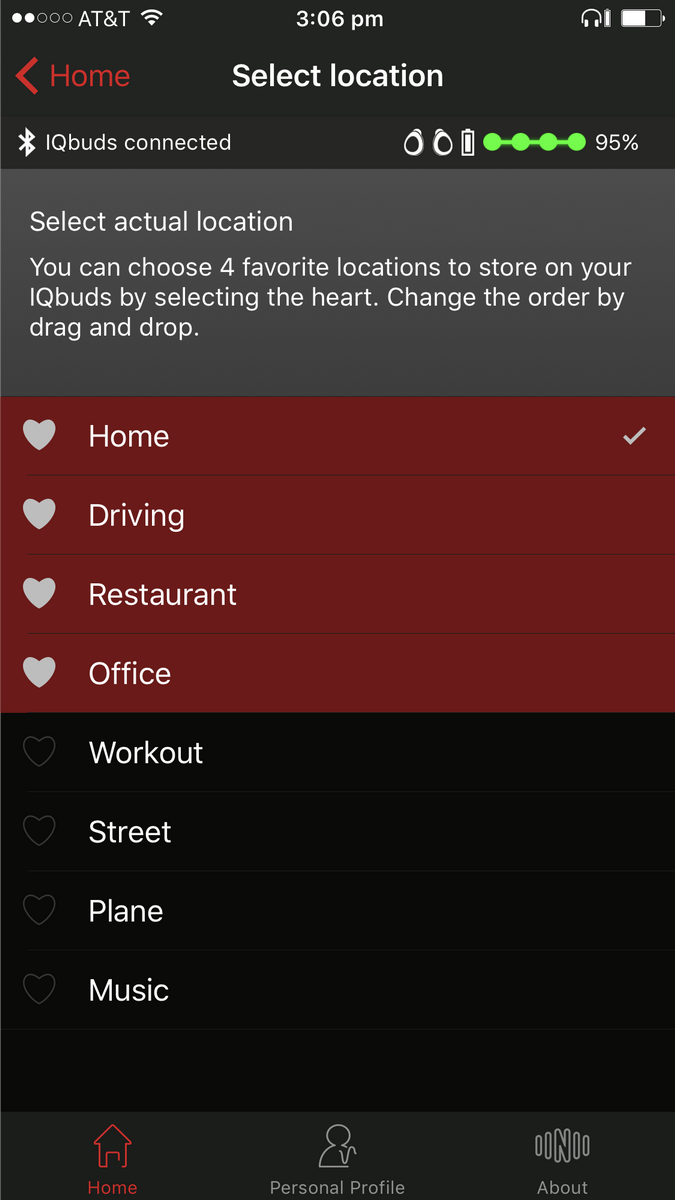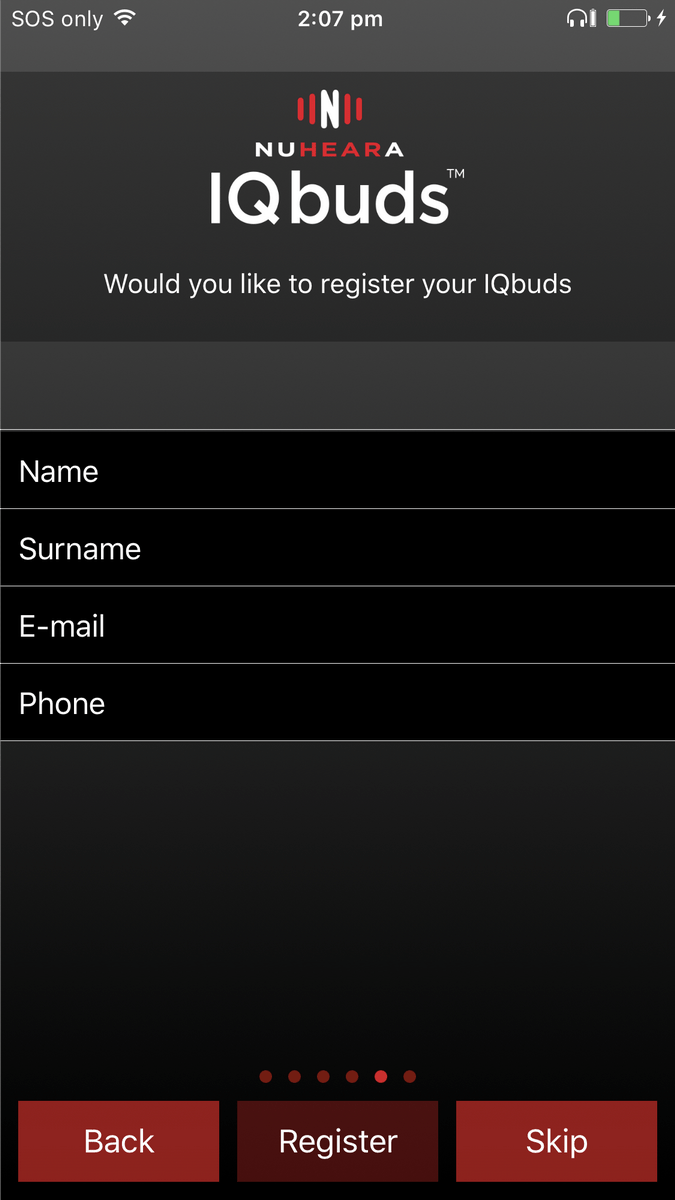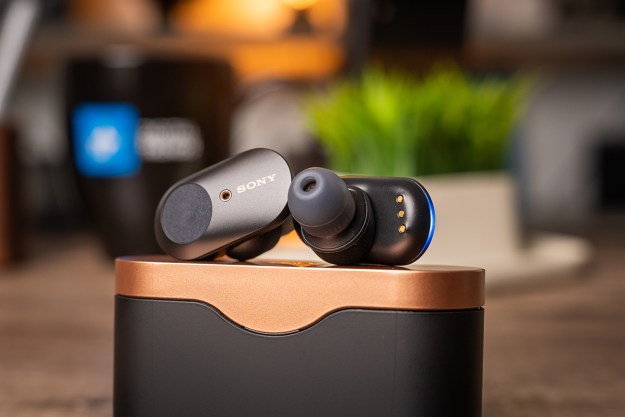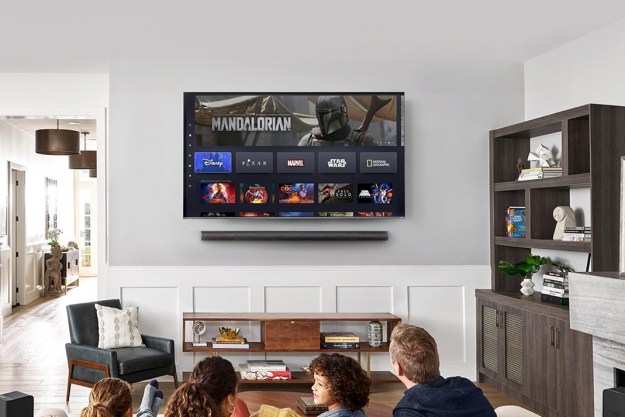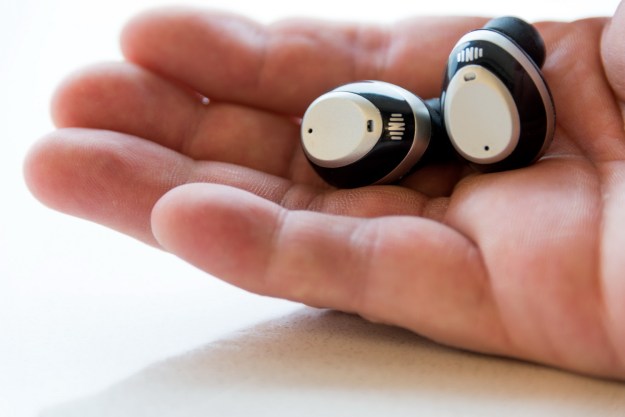
- Excellent speech optimization
- Impressive music streaming
- Good battery life
- Fully customizable sound characteristics
- Easy switching between music, phone, and speech
- Minor wind noise
Nuheara’s IQbuds are among the first truly wireless earbuds that promise to help you understand speech. They’re very good for listening to music and for hands-free phone calls, but their best feature is their voice augmentation.
The IQbuds’ primary purpose is to help people control ambient sound and boost speech simultaneously, and they exceeded our expectations. The earbuds don’t pretend to be hearing aids — they are not medical devices and won’t restore hearing. But if you could use a little boost in others’ speech volume and in separating speech from background noise (like this reviewer), these are the wireless buds for you.
Out of the Box
Inside the IQbuds’ Apple-esque box, you’ll find the earbuds, a portable charging case, and a 12-inch USB charging cable. The charging case has four LEDs on its front lip to indicate the relative charge status of the case itself, plus two more LEDs inside that indicate whether the earbuds’ batteries are charging or full. Accessories include four sizes of earbuds (S, M, L, XL) in both round and oval shapes, written instructions, and even a thank you card with a $20 discount code from Nuheara to share or use yourself — a nice touch.
Setup
Like virtually all true wireless earbuds, the first step is to charge the earbuds fully in their case. It takes 1.5 hours to charge the IQbuds, and 2.5 hours to fully charge the case, so the best idea is to plug them in for 4 hours. You can check the charging status without opening the case by pushing a small button in front — a short press shows the earbud charging status and a longer press shows the case charging status.
Next up is choosing the eartips that give you the best fit. The goal is to fully block the ear canal without sacrificing comfort — we found the large oval eartips fit best. To pair the IQbuds with your phone, open the IQbuds app, put in the buds, and touch and hold the outer surfaces of both for 5 seconds. The buds verbally announce “pairing,” and then you complete the process using your smartphone’s Bluetooth settings.
Features and Design
The IQbuds are similar in design to Bragi’s Dash Earphones, and Doppler Labs’ Here Ones. Two small openings on each bud for integrated microphones let you listen to music or phone calls without missing the sounds around you. The earbuds have L and R indicators on their inner surfaces to make it easy to tell them apart.
Music streaming and hands-free calling were impressive.
Touching the side of each ‘bud controls different features: A single tap on the left earbud plays or pauses music from your phone. If a phone call comes in, music shuts off, and a single tap answers the call. A long tap rejects the call or hangs up a call in progress. Single-tapping the right earbud toggles voice augmentation mode on or off. A long tap switches location profiles, and double-tapping either bud activates Siri or Google Now. All other controls and configuration settings are handled by Nuheara’s proprietary smartphone app, which we’ll get into below.
Nuheara added the Custom Tap Touch feature to the IQbuds with firmware release 1.2.0 on October 3, 2017. This feature allows users to configure the tap touch controls in both buds based on personal preference. Eight different functions can be set to work with single, double, long, or short taps with the left or right earbud. The functions available are World on/off, volume up, volume down, next track, back (previous) track, play/pause, change location, and activate Siri/Google Now.
Configuring Custom Tap Touch in the IQbuds is simple with the included Tap Touch menu. First, pick one of six tap touch choices — for example, Left Double Tap. Six choices for that tap choice are presented, with Google Assistant, in this case on an Android phone, showing as the default or current choice. To select another action, such as Play/Pause, simply tap on the action box for that choice and the change is made on the buds immediately, assuming the IQbuds are connected with the smartphone app. Note: If the Bluetooth connection between buds and app is broken, the IQbuds app will not load.
As for battery life, in our tests, the IQbuds lasted for 3.5 hours playing continuous music or about 5.25 hours with just the sound filters on a single charge. We tested the sound augmentation both with the default settings and with our own configuration, which were quite close. In comparison, Doppler Labs’ Here One offer only 2 hours of music streaming and around 3 hours of sound augmentation.
The app
The IQbuds’ app is relatively straightforward, though it may take some time to get the hang of it. In the Personal Profile app setting page, you can set overall amplification, relative volume for each ear, and frequency boost settings. Similar to Doppler Labs’ Hear One earbuds, the app also allows you to set up a personal hearing profile and then configure different location settings, which lets you adjust general location noise and speech handling based on the real-world sound characteristics of each.
There are eight location-based filters available, including Home, Driving, Restaurant, Office, Workout, Street, Plane, and Music. Only four can be selected directly from the IQbuds, so those four are the ones you select in the app as favorites by tapping on a heart icon.
For each of the eight locations, you must first configure IQVolume, which controls the ambient sound using a circular slider. The default for several settings — always a good place to start — is with the slider set to around 2 p.m. or 3 p.m.. Next, you set what Nuheara calls Super Intelligent Noise Cancellation, or SINC. This is the setting that helps separate voices from the ambient sound. The default setting varies by location, but a good place to start is one hour ahead of the IQ Volume. So if the overall volume setting is 3 p.m., set the SINC level at 4p.. Last you can click Live EQ and, using another circular slider, adjust noise cancellation based on frequencies.
You can always reconfigure the location settings through the app, and they reset in the earbuds. It took us about a week of testing various locations to get the sound settings right for our hearing. Once it was set, we made very few changes.
To assist those with balance issues between ears, there are also two vertical bars with slider adjustments for each ear. If you want general sound amplification, move the sliders to the center position on each side and then adjust them relative to each other, so the sound is centered. In our testing, we listened to music and moved the sliders up or down until the lead singer’s voice was centered. There are five equalizer settings available here, and you can adjust them separately for each ear.
Nuheara’s Blend mode, which you adjust with the Music location settings, allows you to listen to music or phone calls without missing sounds around you. With that setting properly configured, we were surprised how clearly we could hear someone speaking while we still rocking out.
Comfort
The two measures of a good fit with earbuds are comfort and performance. Choosing the proper ear tip is often the key for both. Within about a week, we started to forget we even had the earbuds in our ears, which speaks volumes about the comfort level you can achieve with the right fit.
Daily Performance
It takes about 1.5 hours to recharge the IQbuds from zero, but we weren’t wearing them all day, and it was easy to keep them charged. When we took them out, they went into the charging case, and every second or third day we’d plug in the case overnight. Of course, we’d like longer battery life, but in our real-world use, we never ran out of power.
Like many other true wireless earbuds in the current generation, Nuheara’s IQbuds employ NXP’s wireless Near Field Magnetic Induction (NFMI) to synchronize sound between the two earbuds. We never noticed a difference in synchronization between the left and right earbuds.
Special notes about daily use: When we first tested the IQbuds, wind noise outside was noticeable with the slightest breeze. When we wore the earbuds while eating we could hear our own chewing. At the time, Nuheara told us it was working to cancel or minimize those sounds. After two weeks, we acclimated to both sounds, so while they were a bit of a bother, neither was it a buzzkill.
With the October 2017 firmware 1.2.0 update, however, wind noise outside was significantly decreased. Previously, just the motion of walking was enough to create a noticeable whooshing noise, but with the firmware update, the noise level is barely noticeable. Chewing food is still quite audible with the buds, but that was the lesser problem originally and is no big deal now.
Music playback and phone calls
Music playback and hands-free phone calls were impressive with the IQbuds. Listening to a variety of musical styles via Spotify exceeded expectations. We were pleased with the depth of the bass, clear upper frequencies, and easily discernable mid-range sound – a frequency range which tends to be jumbled with far too many headphones, we’ve found.
Voice calls tended to be loud and crisp. When we asked people on the phone how we sounded, they did not know we were using earbuds and noticed none of the fairly common Bluetooth issues, such as voices fading into the background.
Speech Enhancement
While the IQbuds are great for music and phone calls, those looking for music streaming first don’t need to pay $300 for IQbuds — there are plenty of other choices at half the price. Noise cancellation and voice augmentation to better hear other people’s speech is why most people will choose hearables in this price bracket.
We tested the IQbuds for speech enhancement in a wide range of settings, including restaurants, networking meetings, a crowded church, and driving on the highway. In our first few tests we were surprised how clearly we could hear other people both sitting directly across from us in a loud deli and across a meeting room with hard acoustics. The voices weren’t louder, but they very more clear. It was the first time in years we heard every speaker introduce themselves at a networking meeting.
Within about a week we started to forget we even had the IQbuds in our ears.
The improved ability to understand what other people were saying was dramatic, compared to this reviewer’s normal issues with speech clarity. When we ate at the loudest restaurant in town, sitting in the middle, we didn’t have to ask our lunch companion or the waiter to repeat even once. While driving on the highway in an SUV during out testing, we were aware of the loud tire noise. After dialing back the ambient sound setting at the next stop, the noise was much duller and no longer interfered with conversation.
In the middle of a large church packed with 500-600 people, for the first time, we heard the directionality of sound, from the choir to the speakers. Loud clapping that begins each service was dramatically reduced.
Probably the most dramatic improvement was in a home setting, where our incessant need to ask family members to repeat themselves was greatly reduced. All in all, Nuheara’s IQbuds ability to improve voice comprehension was superlative and significantly better than we’d hoped for.
Warranty information
Nuheara has a limited one-year warranty in the U.S. Nuheara can opt to repair or replace the product or refund the purchase price.
Our Take
The IQbuds passed every test we threw at them. Our primary focus was measuring their ability to help those with a moderate hearing loss to understand speech in various settings, and they performed beyond our expectations. They also offer impressive music playback and hands-free calling, with battery life that far exceeds their only real competition in the new “hearables” genre, the Here One.
Is there a better alternative?
As frequently referenced, the IQbuds’ only real competitors are the Doppler Labs’ Here Ones, but the difference in battery life puts the IQbuds ahead for our money. In fact, we wish the IQbuds’ 3.5-hour battery was longer. Those looking for gobs of features could also check out Bragi’s Dash, but those come with their own issues, and they don’t offer ambient sound augmentation. When it comes to features and usability, the IQbuds at this point are the best of the bunch.
How long will they last?
Truly wireless hearables focused on improving speech hearing such as the IQbuds are a brand-new wearables category, and competition will only increase to meet what is likely to be massive demand. However, Nuheara claims the IQbuds’ software and firmware will be updated over time, helping them keep up with future generations. The earbuds and the charging case appear to be sturdy — both survived waist-high drops in various settings. Assuming the batteries last, you should expect years of use.
Should you buy them?
Buy them if you need help hearing what other people say but don’t think (or want to think) you need a real hearing aid. The IQbuds’ music playback is very good, and they are great for hands-free phone calls, but they shine brightest in settings where ambient noise makes it tough to hear others.
Don’t buy the IQbuds if you are deaf or have severe hearing loss; they are not medical hearing aids and will not restore hearing. They do not reduce or cancel tinnitus. If you need more than 3.5 hours of music playback or 5.25 hours of speech enhancement, either lower your expectations or give these a pass.
Update: Nuheara has released a firmware update with a new feature, Custom Tap Touch. Wind noise reduction is also enhanced. We’ve updated the Features and Design and Daily Performance sections with the new details.
Editors' Recommendations
- Jabra’s most affordable workout earbuds debut at CES 2022
- JBL brings Dolby Atmos soundbar and ANC headphones to CES 2021
- Sony WH-1000XM4 Vs. WH-1000XM3: What’s the difference and which should you buy?
- Bose Noise Cancelling 700 vs. Sony WH-1000XM3: Which headphones should you buy?
- Bose Noise Cancelling 700 vs. QC35 II: Are Bose’s newest headphones worth it?





